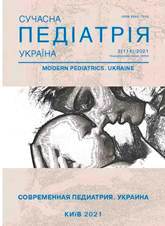Bell's palsy: а literature reference and own clinical case
DOI:
https://doi.org/10.15574/SP.2021.114.83Keywords:
facial nerve, Bell's palsy, flu, inflammationAbstract
Bell's palsy is an acute peripheral paralysis of the facial nerve of unknown etiology. The facial nerve is the seventh cranial nerve. One part of the facial nerve is the motor fibers that innervate the facial muscles. The facial nerve emerges from the brain between the posterior edge of the pons and the medulla oblongata with two roots. The main motor nucleus is responsible for the voluntary control of facial muscles. There are central and peripheral paresis of the facial nerve. Central paresis occurs during а stroke. Peripheral paresis (unilateral muscle weakness of the entire half of the face) develops when the facial nerve is affected from the motor nucleus to the exit from the stylomastoid foramen. Among the various localizations of damage to the peripheral part of the facial nerve, the most common is Bell's palsy as a result of edema and compression of the nerve in the bone canal. Clinical symptoms of facial nerve neuropathy are characterized by acute paralysis or paresis of facial muscles: smoothed skin fold on the affected side of the face; swelling of the cheeks; an inability to close the eyelid, Bell's symptom; facial muscle weakness. The degree of damage is determined by the House Brackmann scale. Treatment with glucocorticosteroids, antiviral drugs, physiotherapy procedures.
Purpose — to present a clinical case of a patient with Bell's palsy as an example of delayed diagnosis, treatment and, as a result, long-term restoration of the facial muscles functions.
Clinical case. The boy after suffering from the flu, began to complain of acute ear pain, vomiting, lack of movement in the right half of the face, dizziness, insomnia. Asymmetry of the face, lack of movement of the right side of the face, inability to completely close the right eye, a symptom of sailing on the right, muscle weakness were revealed during examination. The general condition of the patient improved, facial expressions were restored, sleep was normalized after hormonal, metabolic therapy, physiotherapy procedures.
Conclusions. The article describes a case of inflammation of the facial nerve or Bell's palsy in a teenager who developed on the background of the flu. Timely diagnosis and treatment of the above pathology is the key to a satisfactory prognosis for the restoration of facial expressions, prevention of negative consequences of the the disease.
The research was carried out in accordance with the principles of the Helsinki Declaration. The informed consent of the patient was obtained for conducting the studies.
No conflict of interest was declared by the authors.
References
Baugh RF, Basura GJ, Ishii LE, Schwartz SR, Drumheller CM, Burkholder R, Deckard NA, Dawson C, Driscoll C, Gillespie MB, Gurgel RK, Halperin J, Khalid AN, Kumar KA, Micco A, Munsell D, Rosenbaum S, Vaughan W. (2013). Clinical practice guideline: Bell's palsy. Otolaryngol Head Neck Surg. 149 (3):S1-27. https://doi.org/10.1177/0194599813505967; PMid:24189771
Gronseth GS, Paduga R. (2012). American Academy of Neurology Evidence-based guideline update: steroids and antivirals for Bell palsy: report of the Guideline Development Subcommittee of the American Academy of Neurology. Neurology. 79: 2209-2213. https://doi.org/10.1212/WNL.0b013e318275978c; PMid:23136264
Ho ML, Juliano A, Eisenberg RL, Moonis G. (2015). Anatomy and pathology of the facial nerve. AJR Am J Roentgenol. 204 (6): 612-619. https://doi.org/10.2214/AJR.14.13444; PMid:26001250
House JW, Brackmann DE. (1985). Facial nerve grading system. Otolaryngol. Head Neck Surg. 93: 146-147. https://doi.org/10.1177/019459988509300202; PMid:3921901
Koveshnikov VG. (2008). Human anatomy. In three volumes. Luhansk: publishing house «Shiko» LLC «Virtual Reality». 3: 400.
Madhok VB, Gagyor I, Daly F, Somasundara D, Sullivan M, Gammie F et al. (2016). Corticosteroids for Bell's palsy (idiopathic facial paralysis). Cochrane Database Syst Rev. 7: CD001942. https://doi.org/10.1002/14651858.CD001942.pub5; PMid:27428352 PMCid:PMC6457861
Markin SP. (2017). Facial nerve lesions (pathogenesis, therapy). Journal of neurologis named by B.M. Mankovsky. 5 (1): 65-70.
National Health and Medical Research Council. (2020). Bell's palsy in children (BellPIC). Research Data Australia. Australian National Data Service. URL: https://researchdata.ands.org.au/bells-palsy-childrenbellpic/518554.
Reich SG. (2017). Bell's Palsy Continuum (Minneap Minn). 23 (2): 447-466. https://doi.org/10.1212/CON.0000000000000447; PMid:28375913
Somasundara D, Sullivan F, Gordon F. (2017). Management of Bell's palsy. Aust Prescr. 40 (3): 94-97. https://doi.org/10.18773/austprescr.2017.030; PMid:28798513 PMCid:PMC5478391
Downloads
Published
Issue
Section
License
Copyright (c) 2021 Modern Pediatrics. Ukraine

This work is licensed under a Creative Commons Attribution-NonCommercial 4.0 International License.
The policy of the Journal “MODERN PEDIATRICS. UKRAINE” is compatible with the vast majority of funders' of open access and self-archiving policies. The journal provides immediate open access route being convinced that everyone – not only scientists - can benefit from research results, and publishes articles exclusively under open access distribution, with a Creative Commons Attribution-Noncommercial 4.0 international license (СС BY-NC).
Authors transfer the copyright to the Journal “MODERN PEDIATRICS. UKRAINE” when the manuscript is accepted for publication. Authors declare that this manuscript has not been published nor is under simultaneous consideration for publication elsewhere. After publication, the articles become freely available on-line to the public.
Readers have the right to use, distribute, and reproduce articles in any medium, provided the articles and the journal are properly cited.
The use of published materials for commercial purposes is strongly prohibited.

